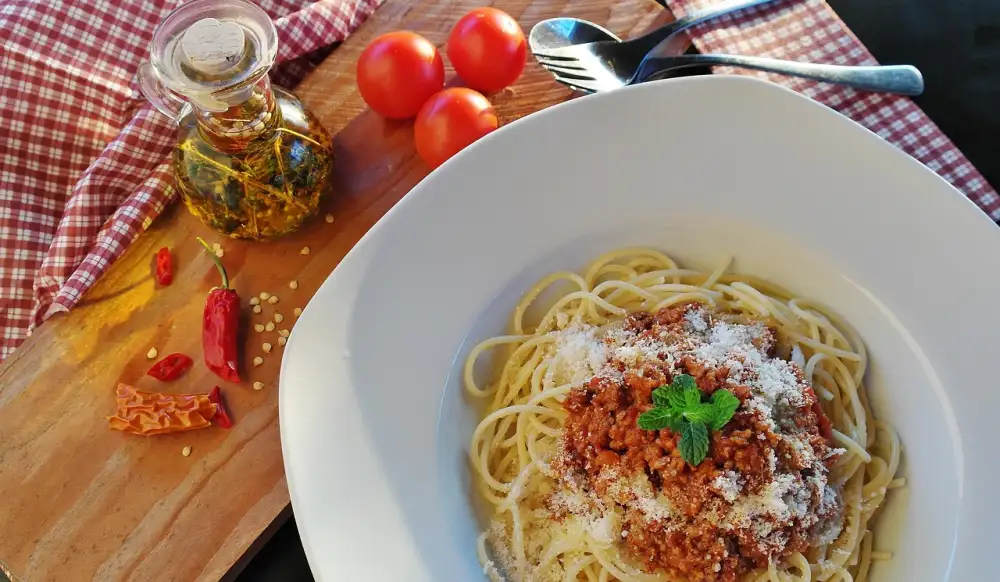Bolognese Sauce: Unveiling the Authentic Italian Recipe for Pasta Perfection

Bolognese sauce, also known as ragù alla bolognese, is a rich and flavorful Italian meat-based sauce that has become a beloved staple in kitchens around the world. This delectable sauce is traditionally served with pasta, but its versatility extends to other dishes as well. With its deep flavors and hearty texture, Bolognese sauce is sure to satisfy even the most discerning palates. In this article, we will delve into the history, ingredients, and preparation of authentic Bolognese sauce, as well as provide tips for perfecting this culinary masterpiece. Get ready to embark on a journey of taste and discover the secrets behind this iconic Italian sauce.
History and Origin of Bolognese Sauce
The history of Bolognese sauce dates back to the 18th century in the city of Bologna, Italy. This rich and flavorful sauce is believed to have originated from the traditional meat-based ragù sauces that were popular in Italian cuisine. However, it wasn't until the late 19th century that the term "Bolognese" was officially used to describe this particular sauce.
The recipe for Bolognese sauce has evolved over time, with various ingredients and techniques being incorporated into its preparation. Originally, the sauce consisted of ground or minced beef, pancetta (Italian bacon), onions, carrots, celery, tomato paste, wine, and milk. The slow cooking process allowed the flavors to meld together and create a hearty and aromatic sauce.
Bolognese sauce gained popularity outside of Italy during the mid-20th century when Italian immigrants brought their culinary traditions to other parts of the world. It quickly became a staple in many households and restaurants due to its versatility and comforting taste.
Today, Bolognese sauce is enjoyed worldwide and has become a classic accompaniment to pasta dishes such as spaghetti or tagliatelle. Its rich flavor profile and meaty texture make it a favorite among pasta lovers everywhere.
Despite its international fame, it's important to note that authentic Bolognese sauce remains true to its Italian roots. The traditional recipe emphasizes slow cooking and using high-quality ingredients like San Marzano tomatoes and finely minced meats. This dedication to authenticity ensures that every bite of Bolognese sauce is a true taste of Italian culinary heritage.
Ingredients for Authentic Bolognese Sauce
To create an authentic Bolognese sauce, you will need a handful of essential ingredients. The key to achieving the rich and flavorful taste lies in using high-quality ingredients that work together harmoniously. Here are the must-have components for an authentic Bolognese sauce:
1. Ground Meat: Traditional Bolognese sauce calls for a combination of ground beef, veal, and pork. This trio adds depth and richness to the sauce.
2. Onion, Carrot, and Celery: These aromatic vegetables form the base of the sauce, providing a savory foundation and enhancing the overall flavor.
3. Tomato Paste: Tomato paste adds a concentrated tomato flavor and helps thicken the sauce.
4. Red Wine: A generous splash of red wine adds complexity and depth to the sauce. Choose a dry red wine like Chianti or Cabernet Sauvignon.
5. Milk or Cream: Adding milk or cream at the end of cooking helps mellow out any acidity from the tomatoes and creates a velvety texture.
6. Beef or Chicken Stock: Stock adds depth of flavor and helps balance out all the other ingredients in the sauce.
7. Herbs and Spices: A classic Bolognese sauce typically includes bay leaves, thyme, oregano, nutmeg, salt, and pepper. These herbs and spices enhance the overall taste profile.
Remember, using fresh ingredients whenever possible will elevate your Bolognese sauce to new heights of deliciousness.
Step-by-Step Guide to Making Bolognese Sauce
1. Heat olive oil in a large saucepan over medium heat. Add finely chopped onions, carrots, and celery. Cook until vegetables are soft and translucent.
2. Increase the heat to medium-high and add ground beef. Break it up with a wooden spoon and cook until browned.
3. Add minced garlic and cook for another minute until fragrant.
4. Pour in red wine and let it simmer for a few minutes until the alcohol evaporates.
5. Stir in tomato paste, crushed tomatoes, bay leaves, dried oregano, dried basil, salt, and pepper.
6. Reduce the heat to low and let the sauce simmer uncovered for at least 1 hour, stirring occasionally.
7. If the sauce becomes too thick during cooking, add a little water or beef broth to thin it out.
8. Remove the bay leaves before serving.
9. Taste the sauce and adjust seasoning if necessary.
10. Serve over cooked pasta of your choice and garnish with freshly grated Parmesan cheese.
Follow these simple steps to create an authentic Bolognese sauce that will impress your family and friends with its rich flavors and hearty texture.
Tips and Variations for Perfecting Bolognese Sauce
1. Use a combination of meats: While the traditional Bolognese sauce calls for ground beef, adding other meats like pork or veal can enhance the flavor and add complexity to the dish.
2. Slow cooking is key: To achieve a rich and flavorful Bolognese sauce, simmer it on low heat for at least 2-3 hours. This allows the flavors to meld together and creates a velvety texture.
3. Don't skimp on the vegetables: The holy trinity of onions, carrots, and celery forms the base of Bolognese sauce. Make sure to finely chop them and cook them until they are soft and aromatic before adding the meat.
4. Wine adds depth: Adding a splash of red wine to your Bolognese sauce can elevate its taste by adding depth and acidity. Choose a dry red wine like Chianti or Sangiovese for best results.
5. Experiment with herbs and spices: Traditional Italian herbs like basil, oregano, thyme, and bay leaves are commonly used in Bolognese sauce. However, feel free to experiment with other herbs and spices like rosemary or even a pinch of nutmeg to give your sauce a unique twist.
6. Balance the sweetness: A touch of sweetness can balance out the acidity in the sauce. You can achieve this by adding a teaspoon of sugar or using grated carrots instead of diced ones.
7. Texture matters: The consistency of Bolognese sauce should be thick but still pourable. If it becomes too thick during cooking, you can add some beef broth or water to thin it out.
8. Let it rest: Once your Bolognese sauce is cooked, allow it to rest for 10-15 minutes before serving. This will allow the flavors to further develop and intensify.
By following these tips and experimenting with variations, you can perfect your Bolognese sauce and create a truly memorable pasta dish.
Serving Suggestions and Pairings for Bolognese Sauce
Bolognese sauce is a versatile culinary delight that can be enjoyed with various accompaniments. The rich and hearty flavors of the sauce make it a perfect match for pasta dishes such as spaghetti, fettuccine, or tagliatelle. The thick texture of the sauce clings beautifully to the strands of pasta, creating a mouthwatering combination.
For a traditional Italian experience, serve your Bolognese sauce over freshly cooked al dente pasta. Top it off with a sprinkle of Parmesan cheese and some fresh basil leaves for added freshness.
If you're looking to add some extra depth to your meal, consider pairing your Bolognese sauce with creamy polenta. The smoothness of the polenta complements the robust flavors of the sauce, creating a truly indulgent dish.
For a lighter option, try serving your Bolognese sauce over zucchini noodles or spaghetti squash. These vegetable alternatives provide a healthier twist without compromising on taste.
If you're feeling adventurous, use your Bolognese sauce as a filling for lasagna or stuffed bell peppers. The savory flavors will infuse into every layer, resulting in a deliciously satisfying meal.
To enhance the overall dining experience, pair your Bolognese sauce with a glass of full-bodied red wine such as Chianti or Sangiovese. The acidity and tannins in these wines complement the richness of the sauce perfectly.
Whether you prefer classic pasta dishes or creative variations, Bolognese sauce is sure to elevate any meal to new heights. So go ahead and savor the authentic Italian flavors by experimenting with different serving suggestions and pairings.
Bolognese sauce is a true culinary treasure that brings together the flavors of Italy in a rich and satisfying dish. Its origins may be debated, but its popularity is undeniable. With a perfect blend of meat, vegetables, and aromatic herbs, this sauce is a delight for the senses.
By following the authentic recipe and using high-quality ingredients, you can create a Bolognese sauce that will transport you to the heart of Italy. The slow cooking process allows all the flavors to meld together, resulting in a deep and complex sauce that will elevate any pasta dish.
Whether you choose to serve it with spaghetti, tagliatelle, or rigatoni, Bolognese sauce is versatile and pairs well with various pasta shapes. The richness of the sauce also makes it an excellent accompaniment for polenta or as a filling for lasagna.
So go ahead and indulge in the goodness of Bolognese sauce. Take your time to savor each bite and appreciate the depth of flavors that this classic Italian dish has to offer. With its comforting aroma and hearty taste, Bolognese sauce truly embodies culinary bliss.
Published: 28. 12. 2023
Category: Food



